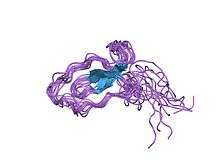Whey Acidic Protein
| WAP | |||||||||
|---|---|---|---|---|---|---|---|---|---|
 | |||||||||
| Identifiers | |||||||||
| Symbol | WAP | ||||||||
| Pfam | PF00095 | ||||||||
| Pfam clan | CL0454 | ||||||||
| InterPro | IPR008197 | ||||||||
| PROSITE | PDOC00026 | ||||||||
| SCOP | 1fle | ||||||||
| SUPERFAMILY | 1fle | ||||||||
| TCDB | 1.C.15 | ||||||||
| |||||||||
In molecular biology, the protein domain Whey acidic protein (WAP) has been identified as a major whey protein in milk and is important in regulating the proliferation of mammary epithelial cells. Additionally, its physiological function is thought to be similar to a protease inhibitor. It has been concluded, therefore, that WAP regulates the proliferation of mammary epithelial cells by preventing elastase-type serine proteases from carrying out laminin degradation and by suppressing the MAP kinase signal pathway in the cell cycle.[1]
Production in mammals
Whey Acidic Protein(WAP) is the major milk protein in certain mammals. There are exceptions in some mammalian species, whereby WAP has not been found to be synthesized in the mammary gland.[1]
WAP motif and cancer
There have been several candidate markers for cancer; most notably genes coding for elafin, antileukoproteinase 1 (previously called secretory leucocyte proteinase inhibitor, SLPI), WAP four disulphide core domain protein 1 (previously called prostate stromal protein 20 kDa, PS20), and WAP four disulphide core domain protein 2 (previously called major human epididymis-specific protein E4, HE4). These genes can be useful biomarkers for detecting tumours.[2]
Biochemistry of WAP motifs
Whey Acidic Protein contains two to three four-disulfide core domain, also termed WAP domain or WAP motif. Each disulfide bond of the WAP motif is made up of two cysteine molecule. This motif is also found in other proteins of different functions, which led to the suggestion that WAP is associated with antiprotease or antibacterial properties. The following schematic representation shows the position of the conserved cysteines that form the 'four-disulfide core' WAP domain
+---------------------+
| +-----------+ |
| | | |
xxxxxxxCPxxxxxxxxxCxxxxCxxxxxCxxxxxCCxxxCxxxCxxxx
| | | |
| +--------------+
| |
+----------------------------+
<------------------50-residues------------------>
'C': conserved cysteine involved in a disulfide bond.
- WAP-type 'four-disulfide core' domain in PROSITE
It has been found that humans and ruminants have the WAP gene in their genome as pseudogene. Although humans and ruminants do not seem to encode the gene, there is no detrimental effect. However, mouse pups feeding on maternal milk lacking Whey Acidic Protein has been associated with poor growth rate and lethality.
References
- 1 2 Seki M, Matsura R, Iwamori T, Nukumi N, Yamanouchi K, Kano K, et al. (2012). "Identification of whey acidic protein (WAP) in dog milk". Exp Anim. 61 (1): 67–70. PMID 22293674.
- ↑ Bouchard D, Morisset D, Bourbonnais Y, Tremblay GM (2006). "Proteins with whey-acidic-protein motifs and cancer". Lancet Oncol. 7 (2): 167–74. doi:10.1016/S1470-2045(06)70579-4. PMID 16455481.